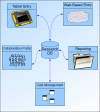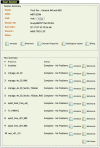Mining the mind research network: a novel framework for exploring large scale, heterogeneous translational neuroscience research data sources
- PMID: 20461147
- PMCID: PMC2866565
- DOI: 10.3389/neuro.11.036.2009
Mining the mind research network: a novel framework for exploring large scale, heterogeneous translational neuroscience research data sources
Abstract
A neuroinformatics (NI) system is critical to brain imaging research in order to shorten the time between study conception and results. Such a NI system is required to scale well when large numbers of subjects are studied. Further, when multiple sites participate in research projects organizational issues become increasingly difficult. Optimized NI applications mitigate these problems. Additionally, NI software enables coordination across multiple studies, leveraging advantages potentially leading to exponential research discoveries. The web-based, Mind Research Network (MRN), database system has been designed and improved through our experience with 200 research studies and 250 researchers from seven different institutions. The MRN tools permit the collection, management, reporting and efficient use of large scale, heterogeneous data sources, e.g., multiple institutions, multiple principal investigators, multiple research programs and studies, and multimodal acquisitions. We have collected and analyzed data sets on thousands of research participants and have set up a framework to automatically analyze the data, thereby making efficient, practical data mining of this vast resource possible. This paper presents a comprehensive framework for capturing and analyzing heterogeneous neuroscience research data sources that has been fully optimized for end-users to perform novel data mining.
Keywords: Mind Clinical Imaging Consortium; XCEDE; XML; data mining; magnetic resonance imaging.
Figures








References
-
- Amari S.-I., Beltrame F., Bjaalie J. G., Dalkara T., De Schutter E., Egan G. F., Goddard N. H., Gonzalez C., Grillner S., Herz A., Hoffmann K. P., Jaaskelainen I., Koslow S. H., Lee S. Y., Matthiessen L., Miller P. L., Da Silva F. M., Novak M., Ravindranath V., Ritz R., Ruotsalainen U., Sebestra V., Subramaniam S., Tang Y., Toga A. W., Usui S., Van Pelt J., Verschure P., Willshaw D., Wrobel A. (2002). Neuroinformatics: the integration of shared databases and tools towards integrative neuroscience. J. Integr. Neurosci. 1, 117–12810.1142/S0219635202000128 - DOI - PubMed
-
- Andreasen N. C., Arndt S., Alliger R., Miller D., Flaum M. (1995). Symptoms of schizophrenia: methods, meanings, and mechanisms. Arch. Gen. Psychiatry 52, 341–351 - PubMed
-
- Aroian L. A., Levene H. (1950). The effectiveness of quality control charts. J. Am. Stat. Assoc. 45, 520–529 Available at: http://www.jstor.org/stable/228072010.2307/2280720 - DOI
-
- Bockholt H. J., Ling J., Scully M., Magnotta V. A., Gollub R. L., White T., Schulz S. C., Lauriello J., Andreasen N. C. (2007). MIND Clinical Imaging Consortium as a Case Study of Novel Multi-Center Neuroinformatics Software Colorado Springs: International Congress on Schizophrenia Research
Grants and funding
LinkOut - more resources
Full Text Sources

